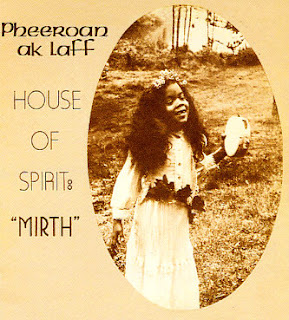Disaster Amnesiac finds the 1990's to be pretty interesting, in terms of music culture, especially music from the era that involves electric guitars. It seems to me that the decade's Rock culture can be triangulated: 1) Immediate post-1980's period, with same old story up above and volcanic activity down below; 2) Nirvana explosion, with paradigm shift in tastes occurring and subsequent major label feeding frenzy; 3) Inevitable "back to business" model in the wake of diminishing returns up above and final fragmentation and music identity/cult formations up above.
I mention all of these factors because
Ray Gun Suitcase, which was released smack dab in the middle of the decade, is the work of band that had a huge hand, explicitly or implicitly, in all three of stated points, and yet rises above all of them in its aesthetic grandeur and vision.
For example, take Head Ubu Man David Thomas, and his lyrical style. Disaster Amnesiac recalls reading press from Pere Ubu at the time of
Ray Gun's release, in which Thomas described his overall conception for the record's lyrics to be an evocation of a Cleveland that remained only as a strong memory in his mind, a ghost town inhabiting a long-gone past. I can hear that in certain songs, such as
Memphis and
Electricity. There are also complex and insightful evocations of human lives in tunes such as
Three Things and
My Friend is a Stooge for the Media Priests; these tunes' lyrics paint pictures that remain far and away superior to most, in their era or others. Of course, Rock lyrics don't have to be poetic, but Thomas's writing on this LP seem to rise to that level. In terms of the stated triangulation, they remain superior to efforts from all three time frames, especially in their deceptively simple approach. They are the stuff of
layers, as regards words. Listen, and be awed. As for Thomas's singular vocal style, one either loves it or hates it. Disaster Amnesiac is firmly in the former camp. One
knows Thomas when one hears him, and, at the time of this recording, he had been sticking to his aesthetic guns for twenty years. His vocal approaches on
Ray Gun Suitcase are indeed many and varied; his "horse snorting" sound on
Electricity has always brought up Deleuze/Guattari-ian thoughts of "becoming animal" in this listener. He whispers, howls, yelps, and even croons his way through the tunes, all the while staying firmly planted within his own, unique, performing identity. Compared to the form fit front men so predominant of the three points of the stated triangle, Thomas sounds so much more compelling, and his performance on
Ray Gun is high even within that standard.
Although Pere Ubu had been in existence for several years before
Ray Gun Suitcase, the band therein was essentially new. Stalwart Thomas was joined by Jim Jones on guitar, Robert Wheeler on synths and theremin, Michele Temple on bass, and Scott Benedict or Scott Krauss on drums (founding member Krauss left mid-recording, I believe). The
Raygun iteration of Ubu, rooted in pre-1990's Rock outplays most then-contemporary bands, twisting and turning in all kinds of ways. Their touch, a physical one, though quite removed from the demonstrative bashing that had become de rigour post-Nirvana, is heavy in a rhythmic way. Jones' guitar solo in
Beach Boys and his high octane riffing in
Red Sky are executed with such graceful command, yet also such simultaneous rawness. Wheeler's creative, spacey theremin and synth parts add great, surreal accents on top of it all. Almost twenty years later, their playing veritably
leaps out of the recordings, from all sections of the band.
The overall feel that Disaster Amnesiac gets from
Ray Gun Suitcase is the same one that Lou Reed got from
Loaded. The album is chock full of songs that could have been hits. Listen to
Beach Boys, with its catchy as hell chorus (and compare it that '95's summer jam by Everclear; you tell me which one is better), or
Memphis, with its smooth motorik groove and stuttering riffage. More examples include Thomas' paean to populist America in
Turquoise Fins (in Pomona!) or the almost Breeders-like (or should that band be described as Ubu-like?)
Down By the River II. Even the more experimental pieces like
Horse or
Ray Gun (Thomas on plastic ray gun) have grown accessible over time.
To get back to the tripartite conception of the 1990's, and its relation to
Ray Gun Suitcase, Disaster Amnesiac is just trying to say that it is an album that transcends such divisions, is transcendent of the simple categorization that is ubiquitous within the music industry. I guess, as such, its chances of wider success within that world were somewhat slight. All that said, the album remains, in a word, timeless.




































